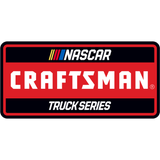
'Black Widow' piece of NASCAR history on the auction block

Want to buy a true old-school NASCAR race car? You'll have your chance at the upcoming Barrett-Jackson Collector-Car Auction in Scottsdale, Arizona.
And when we say old school, we mean old, old school.
In 1957, Chevrolet decided to create a race car that would dominate NASCAR and establish Chevrolet as the car to beat in the minds of buyers across the country. Known as the "Black Widow," the 1957 Chevrolet was one of the most feared race cars of the decade.
The story behind the Black Widow is an interesting insight into how NASCAR and the automobile manufacturers functioned back in the day.
On June 6, 1957, the Automobile Manufacturers Association, a coalition of U.S. automakers, formally banned automobile racing, prohibiting advertising of race results, speed features of race cars, providing pace cars to tracks and other promotional activities. This came in response to heavy Congressional pressure in the wake of a crash at the 1955 24 Hours of Le Mans that killed more than 80 people when a car went off course and crashed into the stands, exploding in a ball of fire.
Rather than have Congress legislate a withdrawal from racing, the automakers did it themselves.
And at the same time, they were doing everything they could behind the scenes to get around their own restrictions. In the case of General Motors, they hired former Hudson lead race engineer Vince Piggins and moved him to Atlanta, where he established a business known as the Southern Engineering and Development Co., or SEDCO, which was run out of Nalley Chevrolet in Atlanta.

Under Piggins' watchful eye, SEDCO built the first Black Widow for competition. The car was based on the economy Chevy One-Fifty Utility Sedan -- or 150, for short -- and featured a host of special go-fast items: a fuel-injected, 283-cubic-inch, 283-horsepower small-block Chevy engine, three-speed manual transmission, six-lug wheels, 20-gallon gas tank and no radio, cigarette lighter or arm rests.
In April 1957, Piggins put together a manual called the "1957 Chevrolet Stock Car Competition Guide," which explained in great detail how Chevrolet dealers could build their own Black Widows. The manual, which was mailed to 411 Chevrolet dealerships, contained 170 individual GM-made parts that were needed to convert a stock Chevy 150 street car to a full-on NASCAR race car.
"This valuable brochure is provided to acquaint dealers, as well as performance-minded individuals, with the techniques that permit greatly safety and entertainment value for all who enjoy stock-car competition in the highest traditions of the sport," GM wrote in the introduction of the manual.
The guide had some interesting details. On color choice, it noted "green is taboo in most American racing circles," an old superstition about the sport.
And it recommended the 150 as the model to race because, "It is rugged and dependable, low in cost, with no unnecessary weight to hamper performance; and conforms with all (NASCAR) sanction requirements."

GM ordered SEDCO to be shut down after the racing ban, but in private hands and with -- allegedly -- no factory support, the Black Widows were raced successfully all season long. Buck Baker would go on to win the 1957 NASCAR Premier Series championship, in a Black Widow. This despite the fact that rules were changed in mid-season to outlaw fuel injection. Others who drove them included Speedy Thompson, Rex White, Bob Welborn and Fireball Roberts.
To this day, the Black Widow remains a subject of much discussion among Chevrolet fans, and intense debate as well. No one knows exactly how many Black Widows were built or how many survived, and the details of the car are a source of endless discussion and fascination among the hard-core fans.
Lot No. 1357 at Barrett-Jackson is described as a "an undocumented frame-off, state-of-the-art, correct restoration of Chevrolet Black Widow car No. 47 driven by Jack Smith. This is one of the original six factory-backed cars."
This particular car is part of Barrett-Jackson's Salon Collection -- the best of the best in the auction -- and will sell on Super Saturday, Jan. 30. This is a no-reserve car, meaning it will sell to the highest bidder, regardless of what the final bid price is.
You can pretty much figure this piece of NASCAR history will fetch a pretty penny when it sells.

A look inside the cockpit of the 'Black Widow.'





































































































































